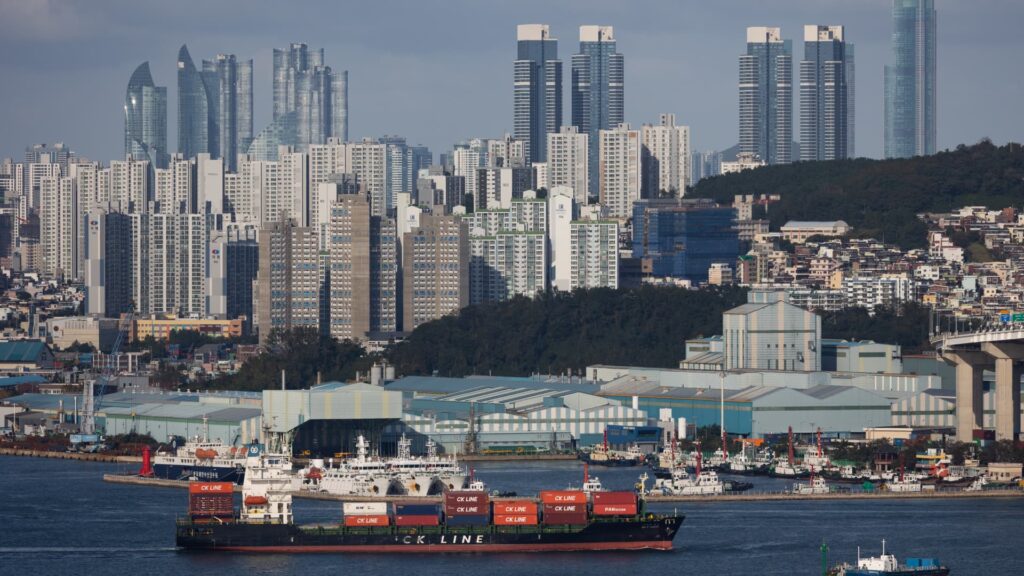A container ship sails in front of a building in Busan, South Korea, Thursday, September 22, 2022. Photographer: SeongJoon Cho/Bloomberg via Getty Images
Bloomberg | Bloomberg | Getty Images
South Korea’s economy expanded at its fastest pace in more than a year, with third-quarter gross domestic product growth beating analysts’ expectations on Tuesday.
According to preliminary estimates by the Bank of Korea, GDP will increase by 1.7% from the previous year, while economists polled by Reuters had predicted a 1.5% increase. Economic growth in the second quarter was 0.6%.
Growth was mainly supported by exports and manufacturing, which expanded by 6% and 3.3% respectively from a year ago, according to Bank of Korea data.
The construction sector has been the biggest drag on the economy, contracting 8.1% year-on-year in the reported quarter.
The growth in exports of goods and services was the fastest since the third quarter of 2024, backed by increased shipments of semiconductors and automobiles.
On a quarter-on-quarter basis, gross domestic product (GDP) increased by 1.2%, exceeding the 0.9% growth forecast in a Reuters poll.
Experts who spoke to CNBC stressed that while exports were strong compared to the same period last year, the growth rate actually slowed compared to the second quarter.
Jin Choi, Korea economist at HSBC, told CNBC that the low base effect from last year pushed up the annual rate. On a quarterly basis, export growth slowed to 1.5% from 4.5% in the second quarter.
“For South Korea’s exports, we believe that signs of front-loading have been relatively limited, but global AI demand is likely to continue to support South Korea’s semiconductor exports,” Choi said.
Homing Li, senior macro strategist at Lombard Odier, said the series of declines was evidence that some front-loaded tariff-related recoveries had already taken place.
Mr Lee said consumption and investment were the main drivers of improved growth in the third quarter, although the front-loading of non-tech exports “may remain” in the face of tariff uncertainty.
These areas were boosted by the resolution of the post-martial law constitutional crisis, consumption voucher programs, and the expansion of the global AI capital investment boom, he added.
HSBC’s Choi said that going forward, the main drivers of South Korea’s growth recovery will be the continued recovery in consumer spending, bottoming out in the construction sector, and expansionary fiscal policy, rather than exports.
trade negotiations
South Korea’s GDP figures were released as the country’s negotiators continue to spar over the details of a trade deal with the Trump administration. In an interview with Bloomberg last Friday, South Korean President Lee Jae-myung said the two countries were stuck on key details over the South Korean government’s $350 billion investment pledge.
“Of course the United States will try to maximize its own interests, but that should not be to the extent that it would have catastrophic consequences for South Korea,” Lee said in an interview.
In July, South Korea reached a trade agreement with President Trump that resulted in a blanket tariff of 15% on South Korea’s exports to the United States, down from the 25% Trump had previously announced. In return, South Korea had promised to invest $350 billion in the United States.
Lee is scheduled to meet with President Trump later this week on the sidelines of the Asia-Pacific Economic Cooperation meeting in Gyeongju, South Korea.
The Bank of Korea said in a statement last Thursday that the economy continues to improve, supported by a sustained recovery in consumption and strong export growth.
The Bank of Korea added, “Domestic demand, centered on consumption, is expected to continue recovering, and exports are expected to remain strong for some time due to the strong performance of the semiconductor sector, but the impact of U.S. tariffs on exports is expected to gradually increase.”
The central bank forecasts full-year growth of 0.9% in 2025 and 1.6% in 2026.

